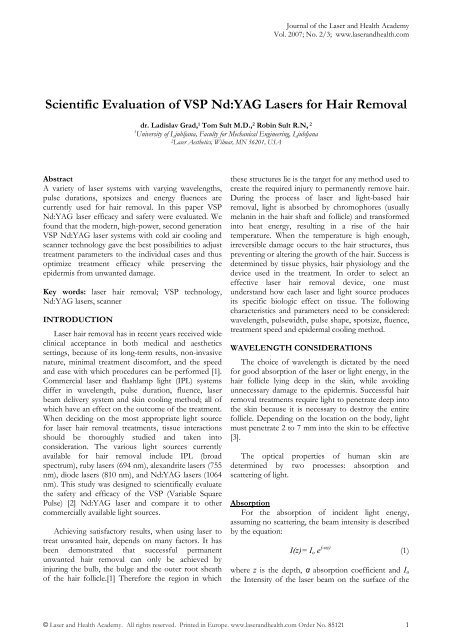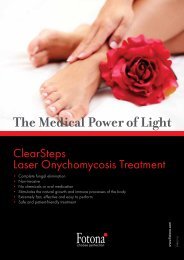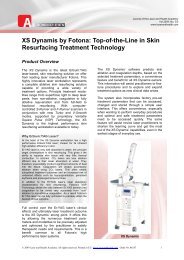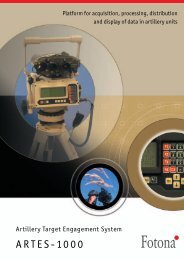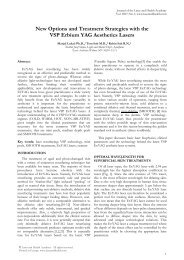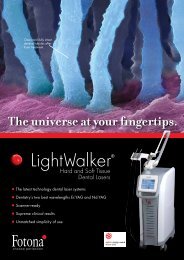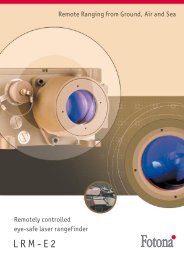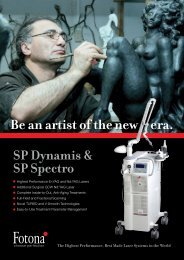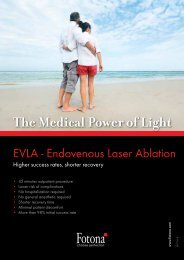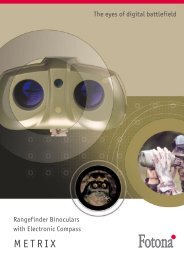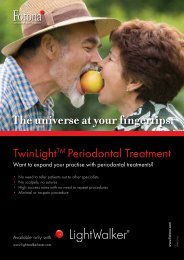Scientific Evaluation of VSP Nd:YAG Lasers for Hair Removal - Fotona
Scientific Evaluation of VSP Nd:YAG Lasers for Hair Removal - Fotona
Scientific Evaluation of VSP Nd:YAG Lasers for Hair Removal - Fotona
You also want an ePaper? Increase the reach of your titles
YUMPU automatically turns print PDFs into web optimized ePapers that Google loves.
Journal <strong>of</strong> the Laser and Health Academy<br />
Vol. 2007; No. 2/3; www.laserandhealth.com<br />
<strong>Scientific</strong> <strong>Evaluation</strong> <strong>of</strong> <strong>VSP</strong> <strong>Nd</strong>:<strong>YAG</strong> <strong>Lasers</strong> <strong>for</strong> <strong>Hair</strong> <strong>Removal</strong><br />
dr. Ladislav Grad, 1 Tom Sult M.D., 2 Robin Sult R.N, 2<br />
1 University <strong>of</strong> Ljubljana, Faculty <strong>for</strong> Mechanical Engineering, Ljubljana<br />
2Laser Aesthetics, Wilmar, MN 56201, USA<br />
Abstract<br />
A variety <strong>of</strong> laser systems with varying wavelengths,<br />
pulse durations, spotsizes and energy fluences are<br />
currently used <strong>for</strong> hair removal. In this paper <strong>VSP</strong><br />
<strong>Nd</strong>:<strong>YAG</strong> laser efficacy and safety were evaluated. We<br />
found that the modern, high-power, second generation<br />
<strong>VSP</strong> <strong>Nd</strong>:<strong>YAG</strong> laser systems with cold air cooling and<br />
scanner technology gave the best possibilities to adjust<br />
treatment parameters to the individual cases and thus<br />
optimize treatment efficacy while preserving the<br />
epidermis from unwanted damage.<br />
Key words: laser hair removal; <strong>VSP</strong> technology,<br />
<strong>Nd</strong>:<strong>YAG</strong> lasers, scanner<br />
INTRODUCTION<br />
Laser hair removal has in recent years received wide<br />
clinical acceptance in both medical and aesthetics<br />
settings, because <strong>of</strong> its long-term results, non-invasive<br />
nature, minimal treatment discom<strong>for</strong>t, and the speed<br />
and ease with which procedures can be per<strong>for</strong>med [1].<br />
Commercial laser and flashlamp light (IPL) systems<br />
differ in wavelength, pulse duration, fluence, laser<br />
beam delivery system and skin cooling method; all <strong>of</strong><br />
which have an effect on the outcome <strong>of</strong> the treatment.<br />
When deciding on the most appropriate light source<br />
<strong>for</strong> laser hair removal treatments, tissue interactions<br />
should be thoroughly studied and taken into<br />
consideration. The various light sources currently<br />
available <strong>for</strong> hair removal include IPL (broad<br />
spectrum), ruby lasers (694 nm), alexandrite lasers (755<br />
nm), diode lasers (810 nm), and <strong>Nd</strong>:<strong>YAG</strong> lasers (1064<br />
nm). This study was designed to scientifically evaluate<br />
the safety and efficacy <strong>of</strong> the <strong>VSP</strong> (Variable Square<br />
Pulse) [2] <strong>Nd</strong>:<strong>YAG</strong> laser and compare it to other<br />
commercially available light sources.<br />
Achieving satisfactory results, when using laser to<br />
treat unwanted hair, depends on many factors. It has<br />
been demonstrated that successful permanent<br />
unwanted hair removal can only be achieved by<br />
injuring the bulb, the bulge and the outer root sheath<br />
<strong>of</strong> the hair follicle.[1] There<strong>for</strong>e the region in which<br />
these structures lie is the target <strong>for</strong> any method used to<br />
create the required injury to permanently remove hair.<br />
During the process <strong>of</strong> laser and light-based hair<br />
removal, light is absorbed by chromophores (usually<br />
melanin in the hair shaft and follicle) and trans<strong>for</strong>med<br />
into heat energy, resulting in a rise <strong>of</strong> the hair<br />
temperature. When the temperature is high enough,<br />
irreversible damage occurs to the hair structures, thus<br />
preventing or altering the growth <strong>of</strong> the hair. Success is<br />
determined by tissue physics, hair physiology and the<br />
device used in the treatment. In order to select an<br />
effective laser hair removal device, one must<br />
understand how each laser and light source produces<br />
its specific biologic effect on tissue. The following<br />
characteristics and parameters need to be considered:<br />
wavelength, pulsewidth, pulse shape, spotsize, fluence,<br />
treatment speed and epidermal cooling method.<br />
WAVELENGTH CONSIDERATIONS<br />
The choice <strong>of</strong> wavelength is dictated by the need<br />
<strong>for</strong> good absorption <strong>of</strong> the laser or light energy, in the<br />
hair follicle lying deep in the skin, while avoiding<br />
unnecessary damage to the epidermis. Successful hair<br />
removal treatments require light to penetrate deep into<br />
the skin because it is necessary to destroy the entire<br />
follicle. Depending on the location on the body, light<br />
must penetrate 2 to 7 mm into the skin to be effective<br />
[3].<br />
The optical properties <strong>of</strong> human skin are<br />
determined by two processes: absorption and<br />
scattering <strong>of</strong> light.<br />
Absorption<br />
For the absorption <strong>of</strong> incident light energy,<br />
assuming no scattering, the beam intensity is described<br />
by the equation:<br />
I(z)= I o e (-αz) (1)<br />
where z is the depth, α absorption coefficient and I o<br />
the Intensity <strong>of</strong> the laser beam on the surface <strong>of</strong> the<br />
© Laser and Health Academy. All rights reserved. Printed in Europe. www.laserandhealth.com Order No. 85121 1
<strong>Scientific</strong> <strong>Evaluation</strong> <strong>of</strong> <strong>VSP</strong> <strong>Nd</strong>:<strong>YAG</strong> <strong>Lasers</strong> <strong>for</strong> <strong>Hair</strong> <strong>Removal</strong><br />
skin.<br />
In day to day practice a more illustrative parameter<br />
is penetration depth δ, defined as<br />
δ =1/α (2)<br />
which tells you at which depth the intensity <strong>of</strong> the laser<br />
beam falls to the level 1/e (36,78%) <strong>of</strong> incident laser<br />
beam.<br />
destroy hair follicles. Furthermore, <strong>Nd</strong>:<strong>YAG</strong> laser<br />
technology is a widely-used and mature technology<br />
which has led to these laser systems having very high<br />
lasing efficiency and beam quality.<br />
Scattering<br />
In addition to absorption according to Eq.1, the<br />
effect <strong>of</strong> light scattering in the human tissue must be<br />
considered. Scattering <strong>of</strong> laser light substantially<br />
influences the beam propagation through tissue and<br />
thus effects absorption [5,6]. [Fig 2]<br />
Fig. 1 shows the absorption characteristics <strong>of</strong><br />
various skin chromophores.<br />
Fig. 2. Penetration depth depends on beam diameter<br />
and laser wavelength.<br />
Fig. 1. Absorption characteristics.<br />
Since light is absorbed by hair melanin throughout<br />
the visible light and near infra red spectrum, there are<br />
numerous wavelengths that can theoretically be<br />
effectively utilized. However, strong absorption in<br />
hemoglobin in small superficial blood vessels prevents<br />
light sources in the 400-590 nm wavelength range from<br />
penetrating deep enough to have an effect on the hair<br />
follicle in hair removal treatments. Early hair removal<br />
devices concentrated on wavelengths in the 650-850<br />
nm range (ruby laser at 694 nm, alexandrite laser at<br />
755nm, diode laser at 810 nm), because <strong>of</strong> their high<br />
absorption in melanin [4]. However, as skin color<br />
darkens with increased amounts <strong>of</strong> melanin,<br />
penetration depth decreases due to competition<br />
between melanin in the skin and melanin in the hair. In<br />
addition, since the epidermis contains relatively high<br />
concentrations <strong>of</strong> melanin [1], laser light is more<br />
readily absorbed, there<strong>for</strong>e increasing the risk <strong>of</strong><br />
undesired thermal injury to the epidermis resulting in<br />
more pain and side effects. For this reason, the latest<br />
generation hair removal devices are based on laser<br />
sources with longer wavelengths. <strong>Nd</strong>:<strong>YAG</strong> laser<br />
devices hold the most prominent position due to its<br />
long wavelength <strong>of</strong> 1064 nm which in terms <strong>of</strong><br />
absorption lies in an optical window that allow light <strong>of</strong><br />
this wavelength to penetrate deep into the skin, while<br />
its absorption in the hair follicle is strong enough to<br />
Once light penetrates into the dermis, the depth <strong>of</strong><br />
penetration becomes strongly influenced by scattering.<br />
The degree <strong>of</strong> laser light scatter in the skin be<strong>for</strong>e<br />
reaching the target chromophores, and there<strong>for</strong>e<br />
preventing any effect on the target, depends on the<br />
laser wavelength. Fig. 3 shows the dependence <strong>of</strong> the<br />
scattering coefficient in skin on laser wavelength. A<br />
high scattering coefficient corresponds to high<br />
scattering in the skin and there<strong>for</strong>e short penetration<br />
depths. As can be seen from Fig. 3, the <strong>Nd</strong>:<strong>YAG</strong> laser<br />
has a low scattering coefficient and thus penetrates<br />
deeper compared to other laser wavelengths that are<br />
also used in laser hair removal treatments.<br />
Fig. 3. A log plot <strong>of</strong> the scattering coefficient <strong>for</strong> skin<br />
as a function <strong>of</strong> wavelength. Note that the scattering<br />
effect decreases with increasing wavelength.<br />
2
Journal <strong>of</strong> the Laser and Health Academy<br />
Vol. 2007; No. 2/3; www.laserandhealth.com<br />
After several scattering events, light no longer<br />
travels unidirectionally in the skin; its direction<br />
becomes random [Fig. 4], causing the light to bounce<br />
back and <strong>for</strong>th inside the skin, until it is absorbed in<br />
one <strong>of</strong> the skin chromophores (<strong>for</strong> example in a hair<br />
follicle). By traveling randomly in skin at this point, the<br />
probability <strong>of</strong> light affecting skin chromophores<br />
becomes higher than if it were to travel through the<br />
skin unidirectionally. This effect in fact further<br />
enhances the absorption <strong>of</strong> <strong>Nd</strong>:<strong>YAG</strong> laser light in hair<br />
structures making this wavelength extremely effective<br />
<strong>for</strong> hair removal.<br />
Fig. 4. Random beam scattering. Due to scattering the<br />
light gets trapped in the absorbing elements such as<br />
hair follicle.<br />
In order to penetrate as deep as the <strong>Nd</strong>:<strong>YAG</strong> laser,<br />
other wavelengths require the use <strong>of</strong> larger spotsizes<br />
and consequently more energy to achieve the same<br />
clinical effect. The influence <strong>of</strong> spotsize on the<br />
penetration depth and the energies required to attain a<br />
certain clinical effect are explained in more detail<br />
further in this paper. To reach the same depth, a ruby<br />
laser would thus require a larger spotsize and energy<br />
than an alexandrite laser, an alexandrite laser in turn<br />
requires a larger spotsize and energy than a diode laser<br />
and a diode would require a larger spotsize and energy<br />
than a <strong>Nd</strong>:<strong>YAG</strong> laser.<br />
Intense Pulse Light (IPL) devices are sometimes<br />
used in aesthetics. These devices emit a very broad<br />
wavelength spectrum <strong>of</strong> light and are there<strong>for</strong>e not as<br />
selective and fine-tuned to particular target tissue<br />
absorption characteristics. They have average<br />
absorption characteristic and average scattering<br />
phenomena.<br />
PULSEWIDTH CONSIDERATIONS<br />
Selective Photothermolysis<br />
Since it is clinically desirable to selectively treat the<br />
hair follicle without producing any injury to the<br />
surrounding tissue, laser energy is always delivered in<br />
single, short pulses. The target tissue approaches its<br />
maximum temperature once the laser pulse has ended.<br />
It then cools by transferring the heat to the adjacent<br />
tissue. The time required <strong>for</strong> the target tissue<br />
temperature to decrease by 63% is the thermal<br />
relaxation time (TRT). In order to destroy the target<br />
tissue and to avoid damage to surrounding tissue, the<br />
laser pulse duration (pulsewidth) should be lower or<br />
approximately the target tissue’s TRT. To avoid<br />
unwanted injury to surrounding tissue, the laser<br />
pulsewidth should be much longer than the TRT <strong>of</strong><br />
the surrounding tissue.<br />
Because the epidermis is the first tissue exposed to<br />
the incoming beam <strong>of</strong> light, injury to the epidermis is<br />
most likely to occur, but only if the energy is delivered<br />
in too short a period <strong>of</strong> time. For this reason, the<br />
pulsewidth should exceed the TRT <strong>of</strong> the epidermis.<br />
Likewise, in order to injure the hair follicle, the laser<br />
energy must be delivered in a pulse <strong>of</strong> which the<br />
duration is shorter than or equal to the follicle’s TRT.<br />
If the pulse is too long, the follicle will be able to<br />
dissipate the energy be<strong>for</strong>e reaching a temperature that<br />
will destroy the follicle. The TRT <strong>of</strong> the epidermis is<br />
estimated to be between 3 and 7 msec [1], depending<br />
on its thickness. The TRT <strong>for</strong> a hair follicle is<br />
estimated to be between 1 and 100 msec [1],<br />
depending on its diameter. The thinner the hair - the<br />
shorter its TRT. Ideally, laser systems <strong>for</strong> hair removal<br />
must be capable <strong>of</strong> delivering laser pulses with a<br />
pulsewidth longer than the TRT <strong>of</strong> the epidermis (e.g.<br />
5 msec), but shorter than the TRT <strong>of</strong> the treated hair<br />
follicle (e.g. 15 msec). [Fig. 5, Fig. 6] Some commercial<br />
devices are capable <strong>of</strong> producing sufficient energy in<br />
pulsewidth durations that fall within these<br />
specifications, but many devices, especially diode lasers<br />
and IPL devices are not. Namely their pulse power<br />
generating capacity is not high enough to deliver<br />
sufficient energy in short enough pulsewidth durations.<br />
Fig. 5: Ranges <strong>of</strong> tissue relaxation times.<br />
In Fig. 6 it is demonstrated that in short laser pulses<br />
( short pulsewidth) the TRT <strong>of</strong> the epidermis is<br />
reached while in long laser pulses (long pulsewidth) it<br />
is not. Short laser pulses are there<strong>for</strong>e more likely to<br />
cause injury to the epidermis than long laser pulses.<br />
3
<strong>Scientific</strong> <strong>Evaluation</strong> <strong>of</strong> <strong>VSP</strong> <strong>Nd</strong>:<strong>YAG</strong> <strong>Lasers</strong> <strong>for</strong> <strong>Hair</strong> <strong>Removal</strong><br />
An additional advantage <strong>of</strong> <strong>VSP</strong> technology is that<br />
it allows the user to easily adjust the pulsewidth and<br />
laser power, or even <strong>for</strong>m a controlled train <strong>of</strong><br />
micropulses within a larger overall pulse thereby<br />
optimizing the efficacy and safety <strong>of</strong> treatments, by<br />
making each pulse with a particular pulsewidth<br />
completely predictable from a clinical outcome point<br />
<strong>of</strong> view.<br />
Fig. 6: The rise in epidermal and hair follicle<br />
temperature is dependent on the laser pulse duration.<br />
VARIABLE SQUARE PULSE TECHNOLOGY<br />
As discussed, light energy must be delivered into<br />
the skin in appropriately short pulses to be safe, and<br />
yet remain effective by thermally only affecting the<br />
desired target tissues. To generate light pulses with a<br />
high enough energy content to be effective, most<br />
devices rely on standard Pulse Forming Network<br />
(PFN) technology. PFN pulses have a typical temporal<br />
shape (shown in Fig. 7) with a slow rise time and a<br />
relatively long declining tail; the pulse power is not<br />
constant during the pulse and the exact pulsewidth is<br />
not defined. While PFN pulses have been shown to be<br />
useful and effective <strong>for</strong> hair removal; newer, more<br />
advanced Variable Square Pulse (<strong>VSP</strong>) technology<br />
generates pulses that provide much higher treatment<br />
precision, efficacy and safety. Fig. 7 shows a square<br />
pulse generated using <strong>VSP</strong> technology compared to a<br />
standard laser pulse. A significant difference between<br />
the two types <strong>of</strong> pulses is that the average power and<br />
the peak power <strong>of</strong> a square pulse is nearly the same,<br />
which cannot be said <strong>for</strong> PFN generated pulses. This<br />
means that the effect <strong>of</strong> <strong>VSP</strong> pulses on the skin is far<br />
more predictable than PFN pulses, which ultimately<br />
leads to superior treatment outcomes, with less<br />
discom<strong>for</strong>t and fewer side effects.<br />
Second generation <strong>VSP</strong> Technology<br />
The majority <strong>of</strong> first generation hair removal laser<br />
systems produce pulses that are significantly shorter in<br />
duration than the epidermal TRT. This causes<br />
excessive injury to the epidermis and unwanted side<br />
effects. Second generation <strong>Nd</strong>:<strong>YAG</strong> laser systems<br />
based on the Pulse Forming Network (PFN)<br />
technology are capable <strong>of</strong> producing laser pulses <strong>of</strong><br />
longer durations. However, many <strong>of</strong> these second<br />
generation systems use a “double pulse” method that<br />
may be misleading to the user. Fig. 8 shows a typical<br />
double pulse sequence emitted by a PFN <strong>Nd</strong>:<strong>YAG</strong><br />
laser system and shows how laser energy is emitted in<br />
two single micropulses separated by a time period that<br />
is defined by such devices as the laser pulsewidth. This<br />
method does not improve safety <strong>for</strong> the epidermis<br />
since most <strong>of</strong> the heating is achieved within short<br />
periods <strong>of</strong> micropulses. Since all the laser energy must<br />
be delivered in two micropulses, the single pulse<br />
energy, and there<strong>for</strong>e instantaneous temperature<br />
increase is relatively high. Note also that the second<br />
pulse does not contain much energy and that there<strong>for</strong>e<br />
most <strong>of</strong> the energy is contained in the first pulse.<br />
Fig. 8. A typical two pulse sequence <strong>of</strong> some PFN<br />
<strong>Nd</strong>:<strong>YAG</strong> laser devices: pulsewidth is simply adjusted<br />
by changing the interval between two pulses.<br />
Fig. 7. Comparisons between PFN and <strong>VSP</strong> shaped<br />
pulses.<br />
The pulse structure <strong>of</strong> Variable Square Pulse (<strong>VSP</strong>)<br />
technology <strong>Nd</strong>:<strong>YAG</strong> laser systems is much better<br />
adjusted to the TRT requirements <strong>of</strong> skin tissue. Fig. 9<br />
shows a typical pulse structure <strong>of</strong> a <strong>VSP</strong> laser pulse.<br />
The overall pulsewidth is increased by adding more<br />
micropulses to the overall laser pulse, and not just by<br />
increasing the separation between two micropulses.<br />
4
Journal <strong>of</strong> the Laser and Health Academy<br />
Vol. 2007; No. 2/3; www.laserandhealth.com<br />
Also, the energy is distributed evenly over all<br />
micropulses. This ensures that the pulse width can be<br />
optimized to the particular TRT’s <strong>of</strong> the epidermis and<br />
the hair follicles.<br />
treatments where a uni<strong>for</strong>m fluence is desired over the<br />
whole spot. However, they might be very useful <strong>for</strong><br />
treating vascular lesions.<br />
Special “top-hat” pr<strong>of</strong>iled handpieces (such as<br />
<strong>Fotona</strong> R33, R34, and S11) have been developed <strong>for</strong><br />
hair removal [Fig. 10b, Fig. 11].<br />
Fig. 10. a.) A Gaussian beam pr<strong>of</strong>ile<br />
b). A top-hat beam pr<strong>of</strong>ile<br />
Napaka! Zaznamek ni definiran.<br />
Fig. 9. A typical <strong>VSP</strong> pulse structure <strong>for</strong> different pulse<br />
durations: a) <strong>Fotona</strong> Versa mode 11ms; b) <strong>Fotona</strong><br />
Versa mode 14ms.<br />
When treating patients with lighter skin and thinner<br />
hair, <strong>VSP</strong> technology allows the practitioner to select a<br />
special ACCELERA mode. In this particular mode the<br />
micropulse duration is further reduced in order to<br />
generate higher instantaneous laser powers and local<br />
temperatures <strong>of</strong> the hair follicle. To treat extremely<br />
thin or light color hair follicles, <strong>VSP</strong> technology allows<br />
the practitioner to decrease micropulse widths to 0,1<br />
msec. In conclusion, <strong>VSP</strong> <strong>Nd</strong>:<strong>YAG</strong> laser systems<br />
provide the necessary precision and versatility to<br />
match the pulsewidth with the appropriate amount <strong>of</strong><br />
fluence (energy density) necessary to cause effective<br />
follicular damage.<br />
PULSE ENERGY AND FLUENCE<br />
CONSIDERATIONS<br />
Fluence<br />
The fluence is one <strong>of</strong> the main settings <strong>for</strong> hair<br />
removal. It is defined as energy density:<br />
f= E/S (3)<br />
where f is fluence, E is the energy <strong>of</strong> the laser pulse<br />
and S is the spotsize <strong>of</strong> the laser beam at the skin<br />
surface. Usually it is measured in J/cm 2 .<br />
The typical <strong>Nd</strong>:<strong>YAG</strong> fluence values <strong>for</strong> hair<br />
removal range between 30 to 100 J/cm 2 [5,7,8].<br />
Beam pr<strong>of</strong>ile<br />
Standard laser handpieces emit beams with a<br />
Gaussian pr<strong>of</strong>ile with an energy distribution that<br />
resembles a conical shaped curve [Fig. 10a]. The<br />
principal effect <strong>of</strong> this is to create higher focal fluences<br />
at the centre <strong>of</strong> the spot while the fluence decreases<br />
towards the edge <strong>of</strong> the spot. Gaussian pr<strong>of</strong>ile<br />
handpieces are less appropriate <strong>for</strong> laser hair removal<br />
Fig. 11. An example <strong>of</strong> a top hat pr<strong>of</strong>ile 20 mm spot<br />
size handpiece (<strong>Fotona</strong> R34).<br />
Because <strong>of</strong> their much more homogeneous beam<br />
pr<strong>of</strong>ile, top-hat handpieces are much safer and<br />
effective compared to standard Gaussian pr<strong>of</strong>ile<br />
handpieces. For example, Fig. 12 shows that <strong>for</strong> a<br />
selected fluence on the laser keyboard (which is in<br />
reality only the average fluence), a 4 mm spot with a<br />
“Gaussian” handpiece, will emit laser radiation in the<br />
center <strong>of</strong> the spot with a focal fluence twice the value<br />
<strong>of</strong> the "top-hat" handpiece, and practically zero fluence<br />
at the edges <strong>of</strong> the spot. If a 60 J/cm 2 fluence value is<br />
selected on the keyboard the “Gaussian” handpiece<br />
will emit 120 J/cm 2 at the center <strong>of</strong> the spot.<br />
Fig. 12. Comparison <strong>of</strong> peak fluences <strong>of</strong> Gaussian and<br />
top-hat beam pr<strong>of</strong>iles <strong>for</strong> the same average fluence and<br />
5
<strong>Scientific</strong> <strong>Evaluation</strong> <strong>of</strong> <strong>VSP</strong> <strong>Nd</strong>:<strong>YAG</strong> <strong>Lasers</strong> <strong>for</strong> <strong>Hair</strong> <strong>Removal</strong><br />
4 mm spotsize.<br />
It is important to note that where a user is used to<br />
treating unwanted hair with a top-hat handpiece at<br />
certain selected fluences, a much lower fluence setting<br />
is required when working with a Gaussian handpiece.<br />
This is because <strong>for</strong> the same (average) selected fluence,<br />
the fluence at the center <strong>of</strong> the spot is much higher<br />
with a Gaussian handpiece, .i.e. 3.8 times higher with a<br />
2 mm spot, 3.1 times higher with a 3 mm spot and 2<br />
times higher with a 4 mm spot.<br />
SPOTSIZE CONSIDERATIONS<br />
The inexperienced laser system user may not always<br />
recognize the importance <strong>of</strong> the spotsize <strong>of</strong> the<br />
emitted beam as a treatment parameter. Theoretically,<br />
if the spotsize is increased and the laser energy is<br />
simultaneously increased to maintain the same energy<br />
fluence, the clinical effect should be similar. However,<br />
due to random laser light scattering, spotsize does<br />
make a difference to the treatment outcome. As a<br />
beam propagates into the skin, light scattering spreads<br />
the beam radially outward, which decreases the beam’s<br />
intensity as it penetrates into the skin. This effect is<br />
more pronounced in smaller spotsizes where the<br />
penetration depth is much lower than it would, if only<br />
absorption characteristics were considered.<br />
Fig. 13 shows the deposition <strong>of</strong> laser energy within<br />
the skin <strong>for</strong> three different spotsizes (2, 6 and 20 mm)<br />
<strong>for</strong> the same laser fluence <strong>of</strong> 60 J/cm 2 , based on our<br />
computer simulations. A Monte Carlo numerical<br />
method [9] was used to obtain these results.<br />
As can be seen in Fig. 12 the depth <strong>of</strong> laser energy<br />
penetration increases with increasing spotsize. For<br />
example, the same energy deposition <strong>of</strong> 10 J/cm 3 is<br />
achieved at 1.6mm, 3.7 mm and 7.5 mm (depth <strong>of</strong><br />
efficacy) <strong>for</strong> respective spotsizes <strong>of</strong> 2, 6 and 20 mm.<br />
This means that in principle small spotsizes (e.g. 2-3<br />
mm) are good <strong>for</strong> treatments where heat has to be<br />
deposited superficially in the skin, as in skin<br />
rejuvenation and treatment <strong>of</strong> vascular lesions.<br />
Following the same reasoning, larger spotsizes are<br />
better <strong>for</strong> laser hair removal treatments because the<br />
aim <strong>of</strong> these treatments is to achieve thermal effects<br />
deep in the skin, where the hair follicles are located.<br />
However, the more tissue light has to thermally affect,<br />
the more energy is needed from the laser system. This<br />
means that in practice it is important to optimize the<br />
spotsize and there<strong>for</strong>e the penetration depth to the<br />
actual depths <strong>of</strong> the hair follicles.<br />
It is important to note that the sensation <strong>of</strong> pain<br />
also increases with the laser spotsize. The larger the<br />
spotsize, the more discom<strong>for</strong>t is felt by the patient<br />
[Fig. 14]. For this reason it is advisable not to use a<br />
spotsize that is larger than needed to reach the<br />
necessary depth where hair follicles are located. Also,<br />
scanning a large area with a large number <strong>of</strong> smaller<br />
laser spots with a scanner is there<strong>for</strong>e preferable to<br />
covering the same area with a small number <strong>of</strong> large<br />
laser spots.<br />
Fig. 13. Computer simulated deposition <strong>of</strong> laser energy<br />
within the skin <strong>for</strong> three different spotsizes (2, 6 and<br />
20 mm) <strong>for</strong> the same laser fluence <strong>of</strong> 60 J/cm 2 .<br />
6
Journal <strong>of</strong> the Laser and Health Academy<br />
Vol. 2007; No. 2/3; www.laserandhealth.com<br />
Fig. 14. Pain perception dependence on beam size.<br />
TREATMENT SPEED AND PRECISION<br />
CONSIDERATIONS – LASER SCANNER<br />
Larger spotsizes may be preferred by regular laser<br />
system users as they allow faster coverage <strong>of</strong> the<br />
treatment area. However, this may not be the optimal<br />
choice. The process <strong>of</strong> absorbing and scattering means<br />
that energy becomes concentrated in the superficial<br />
epidermal layer. The larger the spotsize, the larger the<br />
volume <strong>of</strong> skin from which laser light can be scattered<br />
back and absorbed in the epidermis. This means that<br />
the epidermis is heated more when larger spotsizes are<br />
used. Fig. 13 shows that <strong>for</strong> the same laser fluence the<br />
energy deposited in the superficial epidermal layer is<br />
120, 221 and 310 J/cm 3 <strong>for</strong> spotsizes 2, 6, and 20 mm<br />
respectively. Consequently, although with larger<br />
spotsizes laser light penetrates much deeper into the<br />
skin, the level <strong>of</strong> unwanted epidermal heating<br />
increases. To avoid this effect, it is advisable to reduce<br />
fluences as spotsizes are increased, or to significantly<br />
increase the level <strong>of</strong> epidermal cooling. These two<br />
factors combined indicate that while larger spots<br />
penetrate much deeper into the skin they are not<br />
necessarily as safe and com<strong>for</strong>table as medium<br />
spotsizes.<br />
To strike the right balance between spotsize,<br />
fluence and penetration depth, a computer controlled<br />
SOE (Scanner Optimiued Efficacy) technology has<br />
been intrioduced.<br />
Fig. 17: An example <strong>of</strong> a <strong>VSP</strong> <strong>Nd</strong>:<strong>YAG</strong> laser scanner<br />
( <strong>Fotona</strong> S11)<br />
A scanner allows the use <strong>of</strong> medium spotsizes to<br />
cover large skin areas without sacrificing the treatment<br />
speed and efficiency. Advanced scanners, such as the<br />
S-11 from <strong>Fotona</strong>, based on SOE technology [10],<br />
utilizes top-hat distribution technology to minimize<br />
hot spots in the scanning pattern [Fig. 18]. The S-11<br />
scanner also allows users to select a small spotsize (3<br />
mm) <strong>for</strong> shallower skin rejuvenation treatments, and<br />
medium spotsizes (6mm and 9mm) that are capable <strong>of</strong><br />
penetrating deep enough to ensure effective hair<br />
removal treatments while maximizing patient safety<br />
and com<strong>for</strong>t. Combined with a large scan area <strong>of</strong><br />
6.5cm x 6.5 cm (42cm 2 ) and high coverage speeds, the<br />
S-11 scanner is one <strong>of</strong> the most efficient means <strong>of</strong><br />
providing laser hair removal.<br />
Fig. 18. Top-hat pr<strong>of</strong>ile scanning pattern without “hotspots”<br />
compared to Gausion pr<strong>of</strong>ile scanning pattern<br />
with hot-spots.<br />
Another important advantage <strong>of</strong> using a scanner is<br />
spots can be placed far more precisely than manually<br />
covering the same area with a handpiece and individual<br />
spots. Ideally, visual tissue effects are minimal during<br />
laser hair removal treatments and it is there<strong>for</strong>e quite<br />
difficult to distinguish treated areas from non-treated<br />
ones. Inevitably the area covered with a scanner is<br />
larger than the area covered with individual spots,<br />
which simplifies the alignment <strong>of</strong> treatment passes<br />
over the treatment area. The risk <strong>of</strong> accidental overlap<br />
and thus excess thermal heating and spread is<br />
decreased. The use <strong>of</strong> a scanner decreases treatment<br />
time, increases the precision <strong>of</strong> energy placement on<br />
the tissue, there<strong>for</strong>e decreasing fatigue and ensuring<br />
treatment safety.<br />
Long-term clinical experience has shown that the<br />
use <strong>of</strong> a scanner significantly reduces discom<strong>for</strong>t<br />
during the treatment. Since the coverage is computercontrolled,<br />
the laser spots do not have to be applied<br />
onto the skin sequentially next to one another, as<br />
would be the case in a manually per<strong>for</strong>med treatment.<br />
For example, the <strong>Fotona</strong> S-11 scanner is able to scan<br />
the entire scan area during the given time period<br />
without ever depositing one spot directly next to<br />
another. The scanning sequence ‘skips’ spots and lines,<br />
with the ‘gaps’ being filled in progressively with each<br />
pass. In this way it requires four passes to cover the<br />
entire scan area completely, doing this as fast as a<br />
single ‘Sequential’ pass. Such scanning sequence allows<br />
the user to per<strong>for</strong>m hair removal treatments that<br />
require high fluence settings at high repetition rates.<br />
7
<strong>Scientific</strong> <strong>Evaluation</strong> <strong>of</strong> <strong>VSP</strong> <strong>Nd</strong>:<strong>YAG</strong> <strong>Lasers</strong> <strong>for</strong> <strong>Hair</strong> <strong>Removal</strong><br />
EPIDERMAL COOLING CONSIDERATIONS<br />
Light-based hair removal inevitably requires laser<br />
light to pass through the epidermis first be<strong>for</strong>e<br />
reaching the to-be-treated hair follicle. For this reason,<br />
it is important to be able to reduce any unnecessary<br />
heating <strong>of</strong> the epidermis by all means, to ensure patient<br />
com<strong>for</strong>t and avoid any irreversible damage to the skin.<br />
Epidermal cooling can be particularly helpful when<br />
treating patient with darker skin types. Besides<br />
choosing the laser wavelength with the lowest<br />
absorption in the epidermis, and tailoring the laser<br />
pulsewidth, as discussed in previous sections;<br />
epidermal cooling methods should be considered [11].<br />
There are several skin cooling methods, all <strong>of</strong><br />
which extract heat by conduction into an external, cold<br />
medium. The rate <strong>of</strong> epidermal cooling depends on<br />
temperature, contact quality, motion, and thermal<br />
properties <strong>of</strong> the external medium. An optimal cooling<br />
method should cool the epidermis, while not<br />
excessively cooling the hair shaft.<br />
Cryogen spray<br />
One cooling method consists <strong>of</strong> spraying the<br />
epidermis with a cryogenic spray. This spray instantly<br />
evaporates drawing heat from the epidermis. If applied<br />
correctly, the cooling will last <strong>for</strong> the duration <strong>of</strong><br />
exposure to the laser energy. A new application is<br />
required <strong>for</strong> each epidermal area that is being lased.<br />
This is in principle a very precise, but at the same time<br />
a very aggressive cooling method that can cause<br />
damage to the epidermis if applied too heavily, or <strong>for</strong><br />
too long. Cryogen-induced freezing injuries<br />
(permanent hypopigmentation) have been reported.<br />
On the other hand, since short application times are<br />
involved, any failure <strong>of</strong> the cryogenic device, due to<br />
the freezing <strong>of</strong> the instrument tubes and valves, will<br />
not be noticed until after the application <strong>of</strong> laser light<br />
only and will result in epidermal burning[22, 23]. In<br />
addition, if moisture is present in the air, small ice<br />
crystals (frost) will <strong>for</strong>m on the sprayed surface, which<br />
can reflect a substantial part <strong>of</strong> the laser light.<br />
Cryogenic spray cooling methods only cool a very thin<br />
skin layer leaving the layers below virtually unprotected<br />
from unwanted thermal heating.<br />
Contact cooling<br />
Another method to cool the skin is to drag a<br />
constantly chilled metal paddle or a contact window<br />
along the treatment area immediately be<strong>for</strong>e the laser<br />
exposure. For optimum and safe results only the upper<br />
skin layer should be cooled, protecting the epidermis<br />
but not cooling down to the hair root. At present there<br />
is no method to accurately control the depth <strong>of</strong><br />
cooling. Besides that the probes are usually large and<br />
cover the treatment area, thus reducing the visibility <strong>of</strong><br />
the treated area, which slows the treatment time<br />
significantly.<br />
Cold Air cooling<br />
Cold air cooling is the latest method <strong>for</strong> active skin<br />
cooling (see Fig. 19). It delivers a continuous flow <strong>of</strong><br />
chilled air be<strong>for</strong>e, during and after the laser exposure<br />
(pre-, parallel, and post-cooling). It provides more<br />
com<strong>for</strong>table treatments (better analgesic effect <strong>for</strong><br />
patients) and unlimited post-treatment cooling. Posttreatment<br />
cooling is important as it has been shown to<br />
reduce side effects and healing time. With cold air the<br />
treatment is more practical, safer and more pleasant.<br />
Faster treatments are possible since there is no need<br />
<strong>for</strong> time intervals to apply a cryogenic spray or contact<br />
cooling. The treatment area remains visible at all times<br />
during the treatment. The procedure is not dependent<br />
on surface topography facilitating access to specifi<br />
more complex areas i.e. bikini, intergluteal fold, ears,<br />
nostrils, etc. Furthermore, with this non-contact<br />
cooling method, there is no medium disturbing the<br />
path <strong>of</strong> the laser beam and no interface inducing<br />
energy losses caused by dispersion, transmission and<br />
reflections. Finally, it has no disposable requirements.<br />
Fig. 19 A <strong>Fotona</strong> S-11 scanner with an air cooling flow<br />
nozzle.<br />
While air cooling does not require any application<br />
<strong>of</strong> additional cooling gels it has been shown that air<br />
cooling efficiency can be additionally enhanced by<br />
applying laser gel on the treated skin area. This can be<br />
<strong>of</strong> benefit when high laser powers and high scanner<br />
repetition rates are used. The difference in skin<br />
temperatures that can be achieved using the gel is<br />
vividly demonstrated with a high-tech thermal imaging<br />
camera. Fig. 20 shows the effect that the gel has<br />
compared to skin that was cooled only by air. This<br />
additional cooling power means increased levels <strong>of</strong><br />
patient com<strong>for</strong>t during treatments.<br />
8
Journal <strong>of</strong> the Laser and Health Academy<br />
Vol. 2007; No. 2/3; www.laserandhealth.com<br />
since IPL emits light in a very broad spectrum there<br />
are no effective protection goggles since the visibility<br />
through such goggles would be very low. Eye<br />
protection <strong>for</strong> IPL devices is there<strong>for</strong>e difficult to<br />
achieve.<br />
Fig. 20 The effect <strong>of</strong> <strong>Fotona</strong> Cool Skin Laser Gel on<br />
the air cooling efficacy.<br />
The darker (upper) area is the skin cooled by air<br />
only, the lighter area (lower) is the area that has been<br />
treated with gel. The difference in temperatures is<br />
14°C.<br />
EYE SAFETY CONSIDERATIONS<br />
Whenever using medical laser devices appropriate<br />
protective eyewear must be worn by the patient and all<br />
operating personnel to prevent inadvertent exposure to<br />
the eyes.<br />
It is important to note that the same precaution<br />
applies also <strong>for</strong> intense pulse light (IPL) devices. These<br />
devices are sometimes marketed as simple light devices<br />
that are not dangerous to the eye. However, just the<br />
opposite is true and there have been clinical reports <strong>of</strong><br />
eye-injury when working with IPL’s. Studies [12] have<br />
shown that the IPL instruments actually imply a higher<br />
risk <strong>for</strong> eye-injury than a laser would <strong>for</strong> the same<br />
purpose and with much worse consequences. If an IPL<br />
light pulse is fired from a distance <strong>of</strong> 20 cm against an<br />
open eye, the MPE (Maximum Permissible Exposure)<br />
in the cornea can be exceeded by more than 4000<br />
times. The MPE is according to IEC 825-1 standard<br />
the limit above which permanent eye-injuries can<br />
occur. IPL intensities are contrary to the general<br />
opinion dangerous to the eye. When coherent laser<br />
light is directed into an open eye, the light is because<br />
<strong>of</strong> the coherent nature <strong>of</strong> laser light focused on a very<br />
small spot on the retina and only a small part <strong>of</strong> the<br />
retina gets damaged. This is in fact the basis <strong>for</strong> laser<br />
eye surgery since such limited damage is usually not<br />
even noticed by a patient. On the other hand, IPL’s<br />
non-coherent light is not focused on the retina and a<br />
much larger area <strong>of</strong> the retina will be damaged. The<br />
consequence <strong>of</strong> this is that while laser damage might<br />
not even be detected by the patient, IPL damage can<br />
cause blindness. IPL devices imply a much higher risk<br />
<strong>for</strong> eye-injury than would a laser <strong>for</strong> the same purpose<br />
and with consequences far worse. Since laser operates<br />
at a specific wavelength effective eye-protection is<br />
available as highly transparent eye-goggles that absorb<br />
light only at the laser wavelength. On the other hand,<br />
CLINICAL GUIDELINES<br />
In laser hair removal laser settings must always be<br />
balanced in such a way that hair follicles are damaged<br />
while epidermal damage is avoided. When deciding on<br />
the treatment settings, first consider the structure <strong>of</strong><br />
the hair and the skin type. To work safely test spots are<br />
highly recommended. It is recommended to reserve<br />
enough time between the test and the treatment to<br />
allow <strong>for</strong> any adverse effects to manifest. Secondly,<br />
settings should be set to accommodate the tolerance<br />
levels <strong>of</strong> the patient. In general, darker hair in darker<br />
skin types require lower fluence values and longer<br />
pulsewidths <strong>for</strong> effective and efficient hair removal.<br />
A thicker hair will draw in more energy and hold<br />
the energy longer. Its TRT time is long and longer<br />
pulsewidths can be used. While the absorbed energy<br />
has to be kept below the damage threshold <strong>of</strong> the<br />
epidermis, lower fluences are usually used. In case <strong>of</strong><br />
skin types I-III fluences up to 70 J/cm 2 and<br />
pulsewidths up to 50 ms can be used. Skin types IV-VI<br />
requiret more caution and fluences above 40 J/cm 2 are<br />
not recommended.<br />
Thinner hair has a short TRT and the competition<br />
between melanin in epidermis and melanin in the hair<br />
is higher. The best clinical results are there<strong>for</strong>e<br />
obtained with higher fluence and shorter pulsewidth<br />
settings. There<strong>for</strong>e. For such cases, the Accelera mode<br />
(available in <strong>Fotona</strong> devices) with very short<br />
micropulses has been found to be the most efficient<br />
and safe method to accomplish a satisfactory end<br />
result.<br />
Light, blond hair requires even higher fluence<br />
values and shorter pulsewidths to be effectively and<br />
efficiently removed. Again, epidermal cooling is<br />
essential in such treatments.<br />
Deep-lying hair follicles should be treated with<br />
larger spotsizes. As shown in Fig. 2, the deepest<br />
penetration <strong>of</strong> 7 mm can be achieved with a 20 mm<br />
spotsize. At these spotsizes heating <strong>of</strong> the central<br />
epidermal layer is increased due to back scattering <strong>of</strong><br />
light [Fig. 13], and there<strong>for</strong>e the maximum applied<br />
fluence should not exceed approx. 35 J/cm 2 . The laser<br />
energy required to achieve this fluence at a 20 mm spot<br />
size is approximately 110 J.<br />
In most cases, the optimal spotsize <strong>for</strong> hair removal<br />
is between 6 and 9 mm, and with a top-hat laser beam<br />
pr<strong>of</strong>ile. With such spotsizes hair follicles up to 4 mm<br />
deep [Fig. 2] are effectively damaged and the epidermis<br />
can be kept at safe temperatures with cold air<br />
epidermal cooling. In addition, such treatments are the<br />
9
<strong>Scientific</strong> <strong>Evaluation</strong> <strong>of</strong> <strong>VSP</strong> <strong>Nd</strong>:<strong>YAG</strong> <strong>Lasers</strong> <strong>for</strong> <strong>Hair</strong> <strong>Removal</strong><br />
most com<strong>for</strong>table to the patient.<br />
Using the SOE technology it is very easy to cover<br />
large skin areas [Fig. 21][21], even with relatively small<br />
6-9 mm spots. For example, with the <strong>Fotona</strong> S-11<br />
scanner, a 6 mm spotsize, and a fluence <strong>of</strong> 40 J/cm 2 ,<br />
the speed <strong>of</strong> coverage can be more than 3 cm 2 per<br />
second. It is important to note that in order to increase<br />
the speed <strong>of</strong> hair removal, it is necessary to be able to<br />
increase the repetition rate (i.e. the rate at which single<br />
laser pulses can be placed on the skin one after<br />
another), and not the laser energy (or power) <strong>of</strong> a<br />
single laser pulse. Increasing the laser power <strong>of</strong> a single<br />
pulse above optimal levels would just cause damage to<br />
the skin at the irradiated spot. There<strong>for</strong>e, <strong>for</strong> fast and<br />
safe hair treatments it is important that a device can<br />
deliver high average powers P ave (calculated by<br />
multiplying a single spot laser energy with the<br />
repetition rate), and not the power P pulse <strong>of</strong> a single<br />
pulse (calculated by dividing the single spot energy<br />
with the pulse duration). Typical pulse powers P pulse are<br />
in the range <strong>of</strong> kilowatts, but the highest average<br />
power P ave available in today’s laser devices is 130<br />
W.[20]<br />
Generally, underarm, facial and bikini-line hair will<br />
be treated approximately every 4 to 6 weeks, only<br />
when new growth is present.<br />
Forearms, back, chest and legs will be treated<br />
approximately every 2 months, only when new growth<br />
is present. According to clinical experience follicles<br />
treated in the anagen phase will shed hair 2 to 3 weeks<br />
after treatment.<br />
Fig. 21. Be<strong>for</strong>e and after treatment <strong>of</strong> a large treated<br />
area.<br />
CONCLUSIONS<br />
Based on many considerations, the latest <strong>VSP</strong><br />
(Variable Square Pulse) [2]. <strong>Nd</strong>: <strong>YAG</strong> lasers,<br />
combined with the computer controlled SOE<br />
technology are probably the optimal choice <strong>for</strong><br />
per<strong>for</strong>ming safe and effective hair removal.<br />
The <strong>Nd</strong>:<strong>YAG</strong> laser devices hold the most<br />
prominent position among all available laser sources<br />
due to its long wavelength <strong>of</strong> 1064 nm which in terms<br />
<strong>of</strong> absorption lies in an optical window that allows<br />
light at this wavelength to penetrate deep into the skin,<br />
while its absorption in the hair follicle is strong enough<br />
to destroy hair follicles.<br />
Since it is clinically desirable to selectively treat the<br />
hair follicle without producing any injury to the<br />
surrounding tissue, laser energy is always delivered in<br />
single, short pulses. The pulse structure <strong>of</strong> the Variable<br />
Square Pulse (<strong>VSP</strong>) technology <strong>Nd</strong>:<strong>YAG</strong> laser systems<br />
is perfectly adjusted to the Tissue relaxation time<br />
(TRT) requirements <strong>of</strong> skin tissue. It ensures that the<br />
pulse width is optimized to the particular TRT’s <strong>of</strong> the<br />
epidermis and the hair follicles.<br />
Due to random laser light scattering, laser beam<br />
spot size considerations are important. Our study<br />
shows that <strong>for</strong> most cases the best spot size <strong>for</strong> hair<br />
removal is between 6 and 9 mm with a top hat laser<br />
beam pr<strong>of</strong>ile. However, <strong>for</strong> the deepest hair follicles<br />
one must use larger spot sizes, in extreme cases up to<br />
20 mm.<br />
With today’s request <strong>for</strong> speed and precision a<br />
scanner is a must. Advanced scanners, such as the<br />
<strong>Fotona</strong> S-11, utilize top-hat distribution technology to<br />
minimize hot spots in the scanning pattern and allows<br />
users to select a small spot size (3 mm) <strong>for</strong> shallower<br />
skin rejuvenation treatments, and medium spot sizes<br />
(6mm and 9mm) that are capable <strong>of</strong> penetrating deep<br />
enough to ensure effective hair removal treatments<br />
while maximizing patient safety and com<strong>for</strong>t.<br />
In conclusion, the advantages <strong>of</strong> the <strong>VSP</strong> <strong>Nd</strong>:<strong>YAG</strong><br />
lasers are numerous:<br />
a) The appropriate wavelength with low<br />
absorption in epidermis and deep penetration<br />
down to the hair follicles.<br />
b) The possibility to treat all skin types by<br />
sparing the epidermis.<br />
c) The capability <strong>of</strong> generating appropriately<br />
high fluences at sufficiently short pulse<br />
durations in order to be able to treat thinner<br />
and/or lighter hair.<br />
d) The capability <strong>of</strong> delivering top-hat beam<br />
pr<strong>of</strong>iles.<br />
e) The most advanced <strong>VSP</strong> laser technology that<br />
can deliver high energies, high pulse powers<br />
and average laser powers in the same device.<br />
f) The largest range <strong>of</strong> spot sizes to adjust the<br />
depth <strong>of</strong> treatment to the particular skin type<br />
and position on the body.<br />
g) The safest and fastest skin coverage with<br />
computer controlled SOE scanners.<br />
10
Journal <strong>of</strong> the Laser and Health Academy<br />
Vol. 2007; No. 2/3; www.laserandhealth.com<br />
REFERENCES<br />
1. Goldberg D.J., Laser hair removal, Martin Dunitz, 2000.<br />
2. Variable Square Pulse (<strong>VSP</strong>) is a <strong>Fotona</strong> d.d. (www.fotona.eu)<br />
proprietary technology <strong>for</strong> the generation and control <strong>of</strong> laser<br />
pulses.<br />
3. Landthaler M et al, Effects <strong>of</strong> argon, dye and <strong>Nd</strong>:<strong>YAG</strong> lasers<br />
on epidermis, dermis and venous vessels, <strong>Lasers</strong> Surg Med<br />
1986, 6:87-93.<br />
4. Wanner M., Laser hair removal, Dermat.Therapy,<br />
2005,Vol.18, 209-216<br />
5. Raff K., Landthaler M., Hohenleutner U., Optimizing<br />
treatment <strong>for</strong> hair removal using long-pulsed <strong>Nd</strong>:<strong>YAG</strong> lasers,<br />
<strong>Lasers</strong> in Med.Sci., 2004,18:219-222,<br />
6. Baumler W et al, The effect <strong>of</strong> different spot sizes on the<br />
efficacy <strong>of</strong> hair removal using a long-pulsed diode laser,<br />
Dermatol Surg., 2002, 28(2):118-121.<br />
7. Goldberg D.J., Silapunt S., <strong>Hair</strong> removal using a long pulsed<br />
<strong>Nd</strong>:<strong>YAG</strong> laser: Comparison at fluences <strong>of</strong> 50, 80 and 100<br />
J/cm2, Dermatol Surg 2001, 27: 434-436.<br />
8. Tanzi E.L., Alster T.S., Long Pulsed 1064 nm <strong>Nd</strong>:<strong>YAG</strong> laser<br />
assisted hair removal in all skin types, Dermato.Surg,<br />
2004,30:13-17<br />
9. B.C. Wilson and G. Adam. A Monte Carlo model <strong>of</strong><br />
absorption and flux distributions <strong>of</strong> light in tissue. Med. Phys.<br />
1983,10, 824-830<br />
10. Nemeš K. et al, Scanner Optimized Efficacy (SOE) <strong>Hair</strong><br />
<strong>Removal</strong> with the <strong>VSP</strong> <strong>Nd</strong>:<strong>YAG</strong> <strong>Lasers</strong>, (to be published)<br />
11. Rogachefsky A.S., D.J.Goldberg, et al, <strong>Evaluation</strong> <strong>of</strong> a long<br />
pulsed <strong>Nd</strong>:<strong>YAG</strong> laser at different parameters: An analysis <strong>of</strong><br />
both fluence and pulse duration, Dermatol. Surg, 2002,<br />
28:932-936.<br />
12. Hode L, Are lasers more dangerous than IPL Instruments,<br />
Laser Medicine and Surgery, page 6, paper 18, supplement 15,<br />
2003.<br />
13. Energy Feedback Control (EFC) is a <strong>Fotona</strong> d.d.<br />
(www.fotona.eu) <strong>VSP</strong> based technology <strong>for</strong> the measurement<br />
and control <strong>of</strong> individual laser pulses.<br />
14. Olsen EA. Methods <strong>of</strong> hair removal. J. Am Acad dermatol.;<br />
1999,40:143-55<br />
15. Anderson R, Parrish J., The optics <strong>of</strong> human skin, J Invest<br />
Dermatol.; 1981,88:13-19,<br />
16. Galadari I., Comparative evaluation <strong>of</strong> different hair removal<br />
lasers in skin typers IV, V, and VI, Int.J. Derm., 2003, 42, 68-<br />
70.<br />
17. Bencini P.L et al, Long term epilation with long pulsed<br />
neodimium:<strong>YAG</strong> laser, Dermatol.Surg, 25:3, 175:178.<br />
18. Battle E, Hobbs L.M., Laser assisted hair removal <strong>for</strong> darker<br />
skin types, Derm.Therapy, 17, 2004, 177-183.<br />
19. Ferraro G.A et al, Neodymium Yttrium Aluminum garnet<br />
long impulse laser <strong>for</strong> the elimintaion <strong>of</strong> superfluous hair:<br />
Experiences and considerations from 3 years <strong>of</strong> activity,<br />
Aesth.Plast.Surg., 2004, 28:431-434.<br />
20. See www.fotona.eu; <strong>Fotona</strong> XP MAX hair removal laser.<br />
21. Courtesy <strong>of</strong> Robin Sult, Aesthetic <strong>Lasers</strong>, Willmar MN, USA.<br />
22. Suzuki H., Anderson R.R., Treatment <strong>of</strong> melanocytic nevi,<br />
Dermatologic Therapy, Vol. 18, 2005, 217– 226, (p 223).<br />
23. Majaron B, Kelly KM, Park HB, Verkruysse W, Nelson JS.,<br />
Er:<strong>YAG</strong> laser skin resurfacing using repetitive long-pulse<br />
exposure and cryogen spray cooling: I. Histological study.<br />
DISCLAIMER<br />
The intent <strong>of</strong> this Laser and Health Academy publication is to<br />
facilitate an exchange <strong>of</strong> in<strong>for</strong>mation on the views, research results,<br />
and clinical experiences within the medical laser community. The<br />
contents <strong>of</strong> this publication are the sole responsibility <strong>of</strong> the<br />
authors and may not in any circumstances be regarded as an<br />
<strong>of</strong>ficial product in<strong>for</strong>mation by the medical<br />
equipment manufacturers. When in doubt please check with the<br />
manufacturers whether a specific product or application has been<br />
approved or cleared to be marketed and sold in your country.<br />
11


